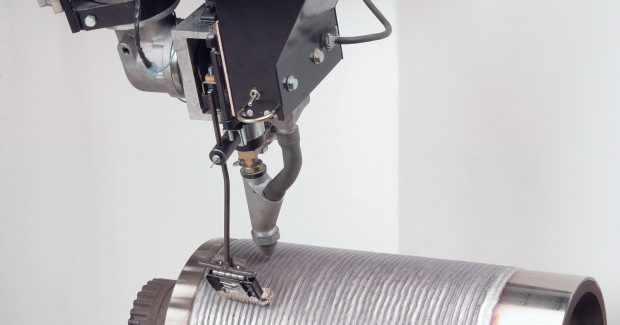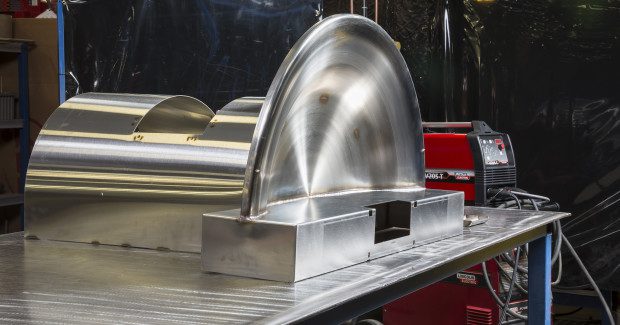Matching Filler Metals to Stainless Steels
Welding stainless remains complicated. Besides paying close attention to heating and cooling the stainless, the filler metal must be properly matched to the base metal with electrodes of the same grade.
Posted: December 1, 2015
The introduction of stainless steel in 1913 offered the promise of better corrosion resistance over carbon steel. And it succeeded, but with some costs and challenges. The original stainless steel held up to its non-rusting claims but had much lower ductility than its standard counterpart. Over the years, metallurgists have experimented with different amounts of alloying materials to enhance performance, but even today, with advances in steel technology, welding stainless remains complicated.
While the technique for welding stainless steel hardly differs from that used in welding standard carbon steel, there are two exceptions. Welders need to pay close attention to heating and cooling stainless. And, they also need to properly match filler metals with the type of stainless material being welded.
UNDERSTANDING COMMON STAINLESS STEELS
Five types of steel, each with numerous variations, fall under the stainless steel umbrella. All are categorized based on their microstructure — the result of both chemistry and the way in which the steel is heated and worked. Microstructure has a large influence on steel’s strength, ductility, and other physical and chemical attributes.
In standard fabrication shops, you most commonly will encounter three types of stainless: austenitic, martensitic and ferritic. Austenitic stainless is the most common type used in fabrication shops. It’s typically identified as the “300 series.” This series does not require preheating, but does have a maximum interpass temperature of 350 deg F. And, some of the 300 series stainless steels – 310, 320 and 330 – are classified as “fully austenitic” and can be susceptible to cracking if you do not use a low-heat-input process and make welds that are flat or concave instead of convex.
Hard martensitic stainless steel is often used in high-wear applications, such as overlays and for building up wear-resistant material, and less for joining. With a high interpass temperature, it’s imperative that you reach an accurate preheat temperature and maintain the minimum interpass temperature the entire time you’re welding. If you don’t, you risk cracking.
Less expensive than other stainless steels, ferritic stainless is a favorite for consumable products, such as components used in automotive exhausts. The two most common grades in this application are 409 and 439. Because ferritic stainless steel comes in thicknesses of ¼ in or less, most welding is done in a single pass. Ferritic stainless steel welding is most successful with low heat input and a maximum interpass temperature of 300 deg F.
A fourth type, duplex stainless steel, is a combination of austenite and ferrite microstructures, making it stronger than either of its components but also more difficult to work with. Finally, precipitation-hardening stainless steels include other alloying elements — niobium, for example — that increase both strength and cost. Both duplex and precipitation-hardening stainless are specialty types used primarily in high-performance applications, such as aerospace and process industries, and we will not go into detail about them.
MAKING A MATCH
Each of the three common stainless steel types used in fab shops has specific factors to consider when it comes to specifying the right filler metal. Much of this is focused around heat conditions, and that can dictate the type of filler metal used. And, in many cases, the match is as easy as selecting a filler metal with the same number as the base metal. That often is the case with ferritic stainless steel, for example.
Other parameters, such as the composition of the base material and the filler metal, can make this seemingly simple matching method a little more complicated. For example, you have 300 series stainless steel grade with an “L” designation included, such as 316L. This L represents how the material has a low carbon content, usually .03 percent carbon. In this case, you would need to match the filler metal number, 316, but also the L. So, for a 316L stainless steel, you would need to use a filler metal with the same designation – 316L.
But there’s more. You might have a 316H base metal on hand, but 316L wire. The numbers are the same, right? It’s not a match. The “H” indicates the base material has a high carbon content. Even though you could weld it using a 316L filler metal, the weld would not hold up once the welded piece is put back into service. Or, consider the challenge of finding a filler metal match for 304 grade austenitic stainless steel. The process to do that isn’t straightforward because a 304 filler metal doesn’t exist. Instead, you would match this material with a 308L filler metal. Its chemistry allows the filler metal to undergo the rapid solidification and cooling associated with welding without cracking.
Another example, 321 base metal, includes small amounts of titanium. However, any titanium in a filler metal would get burned up during the welding process. So, an exact number match is impossible. Instead, if you use a 347 filler metal, you’ll get a consumable that has chemistry similar to 321, but instead has niobium instead of titanium.
Things get even more complicated when you are doing an overlay or joining dissimilar metals. Applications using martensitic stainless steel often fall into this category. As with many other stainless steel varieties, if you are joining martensitic base metals, you probably will use a filler metal with the same number. But sometimes, you can use an austenitic stainless steel filler metal for joining. Or, for overlay work, which is frequently done on carbon steel, 410 is a standard filler metal choice.
HANDLING MIXED OR UNKNOWN MATERIALS
Sometimes, you’ll find yourself in a situation where you need to weld dissimilar metals or unknown base metals, such as during field repairs. It’s easier to match a filler metal than you think. In fact, filler metals with chemistries specifically designed for such situations do exist. It’s not uncommon, for example, to join 304L stainless steel with carbon steel. For a successful weld, consider 309L filler material. It tends to be a good choice for dissimilar metals at temperatures up to about 750 deg F.
If you’re completely unsure of the base metal composition, use an electrode design specifically for repairs. The versatile 312 stainless electrode, which is marketed under various trade names that tout the consumable’s all-around compatibility, offers a weld-all option. It features a chemistry that delivers high strength, corrosion resistance and good ductility. It’s also compatible with most types of base metals. These electrodes tend to cost more than standard wire, but the versatility and performance is worth the investment.
Ultimately, matching filler metal and base metal comes down to using ones that have the same grade. And when you have questions about base metal composition but still need to ensure you can make quality welds, you can choose from versatile specialty electrodes to help you do the job, and do it well. If you run into difficulty finding an exact match for your needs, your welding supply company can help you find the appropriate filler metal to match to the material being welded.

















